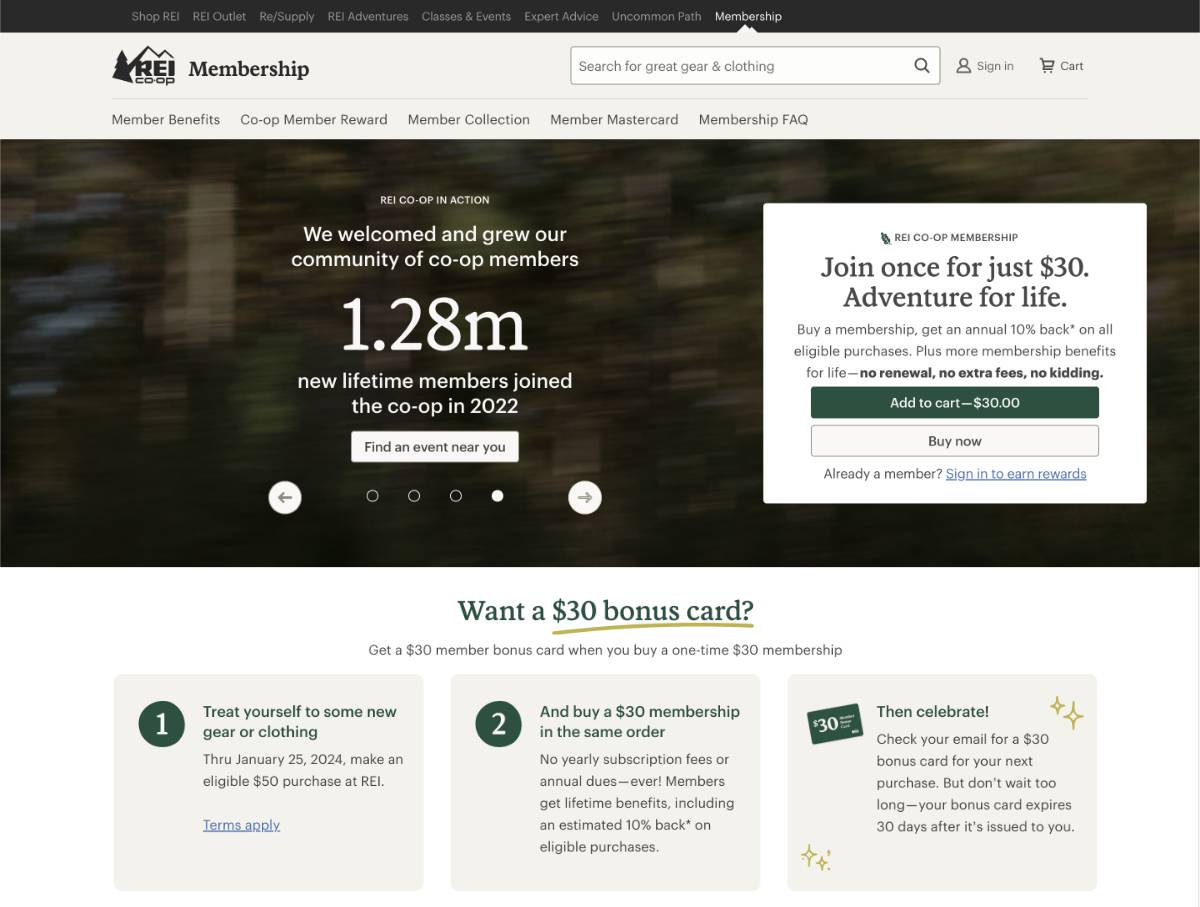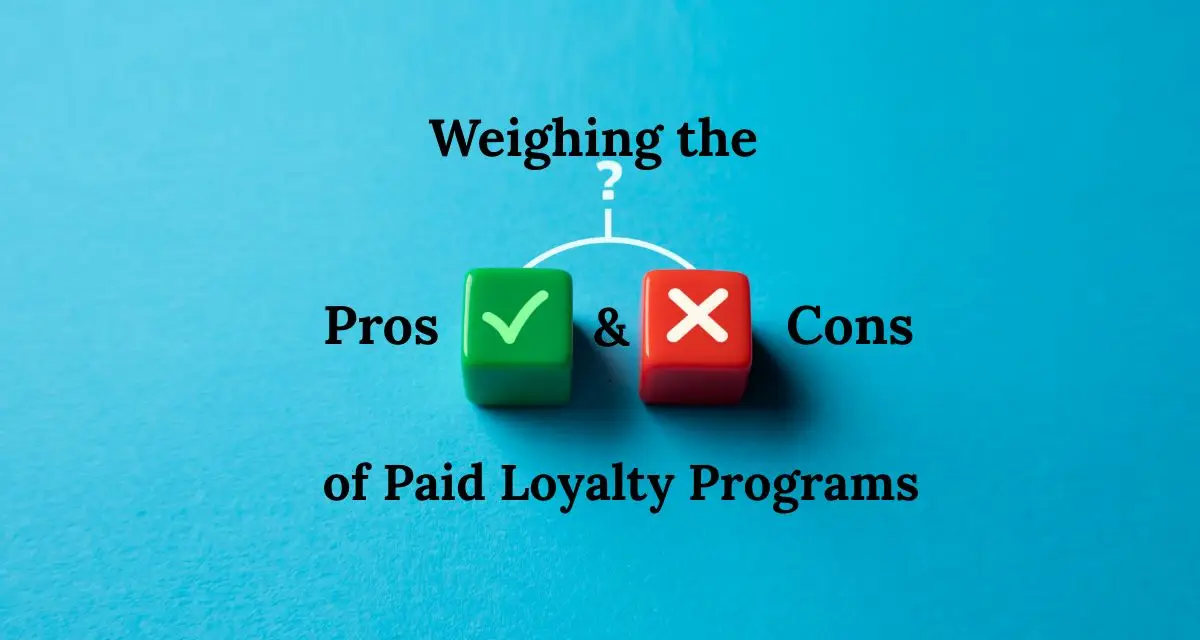The surge in the popularity of loyalty programs has led to the emergence of various program types. A notable category gaining momentum is the paid loyalty program. Such programs offer companies a compelling means to encourage customer retention. Unlike traditional loyalty initiatives, these programs require an upfront investment from customers, pledging exclusive benefits and rewards in return. But, before adopting a paid loyalty program model, brands must carefully consider its pros and cons.
This blog aims to help brands carefully weigh the advantages and disadvantages of a paid loyalty framework. But before delving deep into the intricacies of paid loyalty, let’s first understand paid loyalty programs in detail.
What are Paid Loyalty Programs?
Paid loyalty programs are paid memberships or subscription-based programs offered by brands to incentivize customer loyalty. Unlike traditional loyalty programs that are free to join, paid loyalty programs require customers to pay a fee in exchange for rewards. Members of paid loyalty programs enjoy special perks inaccessible to other customers. These extra benefits encourage customers to continue purchasing over an extended period.

Research suggests that customers who join paid loyalty programs are up to 60% more likely to spend more with the brand after subscribing, compared to before their membership. Furthermore, these members often exhibit a higher retention rate, with companies reporting that paid loyalty program members renew at rates of 70% or higher. This demonstrates the effectiveness of paid loyalty programs in not only encouraging more frequent purchases but also in fostering long-term loyalty among customers, thus increasing the overall value they bring to a company over time.

Paid Loyalty Programs vs Free Loyalty Programs
| Aspect | Paid Loyalty Programs | Free Loyalty Programs |
| Cost to Join | Requires a membership fee or subscription. | Typically free to join. |
| Benefits Offered | Exclusive and premium benefits such as early access to sales, personalized offers, premium customer support, and unique experiences. | Standard benefits, including discounts, points, and occasional promotions. |
| Customer Engagement | Generally, higher engagement due to the financial commitment, personalized experiences, and exclusive perks. | Engagement may vary; customers may be less committed as there is no financial investment. |
| Member Loyalty | Higher likelihood of member loyalty and commitment due to the financial investment. | Loyalty may be less consistent, as members have not committed financially. |
| Revenue Generation | Additional revenue is generated through membership fees. | Revenue is primarily generated through increased sales from repeat business. |
| Competitive Differentiation | Offers a unique selling point and distinguishes the brand from competitors. | Common in the market, may not provide a significant competitive advantage. |
| Customer Acquisition | May attract a more dedicated customer base willing to invest in a long-term relationship. | Appeals to a broader customer base, including those who are more price-sensitive. |
| Flexibility in Benefits | More flexibility to provide premium and tailored benefits to a smaller, committed audience. | Benefits are often standardized and apply to a larger customer base. |
| Ease of Adoption | May face resistance due to the upfront cost of joining. | It is easier to adopt as there is no financial commitment initially. |
| Program Sustainability | Financially sustainable with recurring membership fees. | Sustainability relies on the ability to drive increased sales and customer retention. |
Benefits of Paid Loyalty Programs
1. Identify Your Most Loyal Customers
While numerous customers enroll in loyalty programs with the hope of enjoying discounts, a distinct group of loyal customers places greater importance on accessing the finest offerings from your brand. These individuals are your top-tier customers. They desire to experience the privilege of being recognized as top-tier VIP members. However, providing VIP benefits solely after accruing points proves ineffective with this esteemed customer segment.
For free loyalty programs, members often make numerous transactions before even contemplating the prospect of receiving a reward. And what is this reward? More often than not, it’s a modest $5 coupon for a $100 expenditure. Is such an incentive truly worthwhile?
This approach falls short of fostering genuine loyalty. Your most valued customers require a more compelling reason to remain dedicated. 70% of consumers not currently part of a paid loyalty initiative would readily join if their preferred retailer offered one with valuable benefits.
2. Boost Return on Investment (ROI)
A paid loyalty program guarantees increased purchase frequency, basket size, and brand loyalty. The initial contributions from members fund these initiatives. Brands can leverage membership fees to create unique offerings with a deeper emotional impact, like providing access to personalized experiences or exclusive members-only content.
Consider the pareto principle for loyalty, even if only the most dedicated 20% of your customer base opts for your premium loyalty program, the generated revenue can accumulate rapidly, enabling you to enhance the perks offered to your top customers consistently. This strategy guarantees that your members remain actively involved in your program, renewing their participation year after year.
3. Acquire High-Quality Customer Insights
When customers enroll in paid loyalty programs, they willingly offer details about their shopping patterns, preferences, and personal inclinations. This information undergoes systematic collection and analysis, allowing brands to gain insights into consumer behaviors. During the membership process, brands can collect specific customer data such as purchase history, favored product categories, buying frequency, and demographic details. This data empowers brands to create intricate customer profiles, facilitating personalized marketing strategies.
4. Sustain Long-Term Customer Engagement
Members, having a stronger commitment, will interact more frequently with your brand, reducing the likelihood of them disengaging over time. Paid loyalty program members are 60% more likely to boost their expenditure with your company or store than a mere 30% in free loyalty programs.
Furthermore, almost 62% of consumers are inclined to “spend more on a brand” after participating in its paid loyalty program. Paid loyalty program members also pay a specific amount to join. Members start interacting more with the brand to get back more than their initial investment through earning rewards.
5. Increase in Customer Lifetime Value
Paid loyalty programs stimulate repeat purchases by offering exclusive discounts, promotions, and special access, increasing and maintaining customer loyalty and reducing churn. Paid loyalty programs boast exclusive benefits that encourage customers to spend more, directly elevating the average transaction value which in turn increases customer lifetime value.
Moreover, the data collected through these programs provides valuable insights into customer preferences and behavior, enabling businesses to personalize their marketing strategies and enhance the overall customer experience.
Once loyalty program members receive significant value, they are likelier to become brand advocates, contributing to positive word-of-mouth and expanding the customer base. Furthermore, higher engagement and value also build a stronger emotional connection between customers and the brand, further solidifying loyalty and ensuring sustained profitability through increased CLV.
6. Improved Feedback and Engagement
Paid loyalty programs often involve hyper-personalized rewards. This prompts customers to actively engage with the brand and share feedback on their preferences, past purchases, and expectations.
The heightened engagement also fosters a sense of community and loyalty, as customers feel acknowledged and appreciated. Additionally, paid loyalty programs collect large amounts of data from customers. this data can later be leveraged to tailor marketing strategies and enhance the overall customer experience.
Customers who perceive the benefits of the cusromer loyalty program are more likely to actively participate, resulting in a continuous feedback loop that aids businesses in making informed decisions and refining their offerings.
Cons of Paid Loyalty Programs
1. Limited Appeal to Price-Sensitive Customers
If a loyalty program comes with a price, it might not appeal to customers who prioritize saving money over loyalty perks. Some customers may hesitate to pay for loyalty memberships, especially if they’re accustomed to enjoying free program benefits.
As a result, you might miss out on engaging with a significant customer segment. Therefore, your loyalty program should carefully balance offering premium benefits while ensuring affordability for a broad customer base.
2. Difficulty Retaining Customers
Customers who invest money in a loyalty program often have higher expectations regarding the value and exclusivity of the benefits. If your program fails to meet these expectations, it can lead to dissatisfaction and member churn. Dissatisfaction among paying members can lead to declined sales and negative word-of-mouth.
3. Risk of Overcomplication
A loyalty program should be easy to understand and navigate to ensure a positive user experience. However, with paid loyalty programs, brands might overcomplicate the program structure with numerous tiers, complex benefit structures, or confusing terms and conditions to justify the paid model. This overcomplication can lead to customer confusion and frustration, hindering your program’s effectiveness.
Navigating the Challenges of Paid Loyalty Programs
1. Transparent Communication is Paramount
Clearly articulate the value proposition of the paid loyalty program to potential members, ensuring they understand the exclusive benefits they will receive. This can be done through concise and easy-to-understand content, including FAQs that address common questions and concerns about the program.
2. Managing Customer Expectations
Set realistic expectations and ensure that the program delivers on its promises. If your loyalty program overpromises, it can lead to potential dissatisfaction among paying members. You should clearly outline the program’s benefits, terms, and conditions during sign-up. Furthermore, regularly updating members on upcoming features and exclusive offerings ensures members understand the program’s new features.
3. Balancing Complexity
Simplify the program structure to avoid overwhelming customers with complexity. Focus on a streamlined approach that enhances the user experience. This can be done by utilizing user-friendly interfaces, providing a straightforward rewards system, and offering limited membership tiers to avoid confusion.
4. Pricing Strategy
Carefully consider the pricing model to balance offering premium benefits and ensuring affordability. A thorough market research can help you determine the optimal price point. Furthermore, you can offer a trial period or a tiered pricing structure to cater to different customer segments. Over time, you can monitor customer feedback and adjust pricing as needed.
5. Competitor Analysis
Stay informed about competitors’ loyalty programs to ensure that the paid program remains competitive in the market. Regularly assess competitor offerings, identify unique selling points, and adjust the program’s features and benefits accordingly. Conducting a regular competitor analysis helps you to differentiate the program to stand out in the market.

Paid Loyalty Program Case Study
REI Co-op Membership
REI Co-op is an outdoor retail company that offers a membership program called REI Co-op Membership. Members pay a one-time fee to join and receive a range of benefits. Benefits of the loyalty program include access to exclusive sales and events and special discounts on gear rentals and classes. The program is also committed to environmental stewardship, as REI donates a portion of its profits to outdoor conservation efforts. REI Co-op has effectively overcome the challenges of paid loyalty programs through several key strategies:
1. Value-driven membership: REI Co-op offers its members a range of tangible benefits that justify the one-time subscription fee. These benefits include discounts on products, access to exclusive sales and events, and the opportunity to earn an annual dividend based on purchases. By providing clear and valuable incentives, REI Co-op ensures that members feel they are getting their money’s worth.
2. Experiential rewards: Besides transactional benefits, REI Co-op offers experiential rewards that appeal to its target audience of outdoor enthusiasts. This includes access to classes, day trips, nationwide adventures, and unique local events for the community. By providing opportunities for members to engage in outdoor activities and connect with like-minded individuals, REI Co-op fosters community and enhances the overall membership experience.
3. Environmental stewardship: REI Co-op’s commitment to environmental stewardship sets it apart from other loyalty programs. The company donates a portion of each membership fee to charity and invests in hundreds of nonprofits focused on outdoor conservation. This aligns with the values of its target audience and creates a sense of purpose and impact for members, further enhancing the perceived value of the program.
4. Lifetime membership: REI Co-op offers a lifetime membership, meaning that once a member joins, they have access to the program indefinitely. This eliminates the pressure of annual renewal fees and creates a sense of long-term value for members. It also encourages ongoing engagement and loyalty, as members are vested in utilizing the program’s benefits over time.
By addressing these challenges and providing a compelling value proposition, REI Co-op has been able to overcome the hurdles typically associated with paid loyalty programs and build a strong and loyal customer base.
Best Paid Loyalty Programs Examples
Paid loyalty programs offer members exclusive benefits, often outweighing the cost of the membership fee. Here are short descriptions of three popular paid loyalty programs:
1. Amazon Prime
For an annual fee, Amazon Prime members enjoy free two-day shipping on eligible items, access to streaming services like Prime Video, and exclusive deals not available to non-members. The convenience and savings make it a favorite among online shoppers.
2. Costco Wholesale Club Membership
With this membership, individuals gain access to Costco’s vast selection of bulk goods, electronics, and groceries at wholesale prices. Additional perks include discounts on gasoline and travel deals, providing significant savings for families and businesses alike.
3. Sephora’s Beauty Insider Rouge Membership
Aimed at beauty enthusiasts, this tiered loyalty program rewards members with points for every purchase, redeemable for products or experiences. Rouge members, who reach this status by spending a certain amount annually, enjoy free shipping, exclusive sales, and free beauty services, enhancing their shopping experience.
Paid loyalty programs like these not only foster customer loyalty but also provide a curated set of benefits that enhance the shopping experience, offering both savings and exclusivity.
Technology Trends for Paid Loyalty Programs
Technology plays a crucial role in enhancing the effectiveness and appeal of paid loyalty programs. By leveraging various technological advancements, businesses can cultivate stronger customer relationships, drive repeat purchases, and boost brand loyalty. Here’s a comprehensive overview of how technology impacts paid loyalty programs:
1. Personalization and Segmentation:
Technology enables businesses to gather and analyze vast customer data, including purchase history, preferences, and demographics. This data allows brands to tailor rewards and promotions to individual customers, creating a more engaging and personalized loyalty experience. In addition, understanding consumer behavior and preferences allows businesses to design targeted campaigns and offers that resonate with each individual member.
2. Data-Driven Decision Making
Advanced loyalty data science and analytics tools provide businesses with valuable insights into customer behavior and program performance. These insights can be used to optimize reward structures, identify trends, and make informed decisions about program strategy. For instance, businesses can analyze customer redemption patterns to determine the most effective reward types and redemption values.
3. Mobile Apps and Digital Platforms
Mobile apps and digital platforms have become indispensable tools for managing and engaging with paid loyalty program members. Digital loyalty platform allow members to easily access their account information, track rewards, redeem benefits, and receive personalized offers. Mobile apps also provide a direct communication channel between businesses and their customers, facilitating real-time interactions and feedback.
4. Artificial Intelligence and Machine Learning
AI and machine learning algorithms transform paid loyalty programs by enabling businesses to predict customer behavior and proactively offer relevant rewards and promotions. AI can analyze customer data to identify patterns and trends, predicting future purchases and preferences. This predictive capability allows businesses to tailor rewards and offers in advance, increasing the likelihood of customer engagement and satisfaction.
5. Blockchain Technology
Blockchain technology is emerging as a secure and transparent platform for managing loyalty programs. Blockchain’s decentralized and immutable ledger ensures the integrity of reward transactions, preventing fraud and tampering. Additionally, blockchain can facilitate the exchange of rewards across different businesses or platforms, creating a more interconnected and versatile loyalty ecosystem.
6. Geolocation and Targeted Offers
Location-based technologies allow businesses to send personalized offers and promotions to customers based on their proximity to stores or specific locations. This targeted approach enhances the relevance of rewards and encourages customers to visit physical stores more frequently.
Future Trends and Considerations
In the upcoming era, paid loyalty programs are gearing up for exciting changes. The focus will shift towards providing personalized experiences, employing advanced technologies and sustainable practices.
1. Rise of Partnerships:
Expect more subscription-based models and strategic partnerships to take center stage. These collaborations will play a pivotal role in shaping the future of paid loyalty programs.
2. Emphasis on Mobile-First Experiences and Data Privacy:
The future will prioritize mobile-first experiences and emphasize the utmost importance of data privacy. Paid loyalty programs must adapt to these expectations to thrive in the evolving landscape.
3. Continuous Innovation and Adaptation:
Staying ahead in the competitive arena will hinge on continuous innovation and adaptation. Your loyalty program must be agile and responsive to emerging trends to maintain their relevance.
4. Harnessing Data Analytics and AI for Personalization:
Data analytics and AI in will be harnessed to tailor rewards and offers based on individual preferences. This data-driven loyalty program approach ensures a more customized and engaging experience for program members.
5. Integration of Emerging Technologies:
Brace for integrating emerging technologies like AR, VR, and blockchain, enhancing the overall member experience. These innovations will bring a new additions to the benefits of loyalty programs.
6. Focus on Sustainability and Social Responsibility:
Socially conscious consumers will be attracted to loyalty programs focusing on sustainability and social responsibility. Initiatives in these areas will become integral to the appeal and success of paid loyalty programs in the near future.
Conclusion
The success of paid loyalty programs lies in the exclusivity of benefits, and the adept handling of customer expectations and the strategic use of technology. Brands must remain agile, adapting to emerging trends and incorporating technological advancements to stay ahead in an ever-evolving market.
With consumer expectations continually shifting, businesses that understand the nuances of paid loyalty programs and proactively address their challenges can carve a path toward sustainable growth. The key lies in initiating a program and its ongoing management, ensuring that the value proposition remains compelling, customer communication remains transparent, and technological integration evolves with the times.
Ready to Build Your Loyalty Program With Zinrelo?
Learn how our holistic loyalty platform can transform your business.


